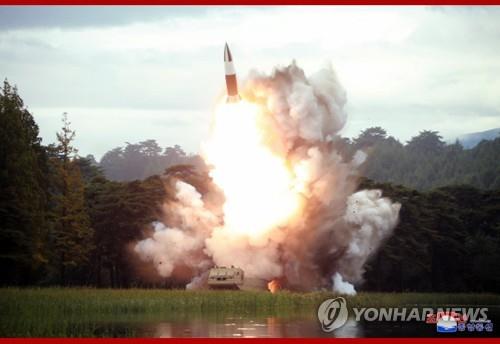North Korea fires two short-range ballistic missiles into East Sea

This photo, carried by the North’s Korean Central News Agency on Aug. 17, 2019, shows the test of a “new weapon” a day earlier. The projectile is believed to be the North Korean version of the U.S.’ Army Tactical Missile System (ATACMS). (Yonhap)
Seoul: North Korea fired two projectiles presumed to be short-range ballistic missiles into the East Sea on Saturday, South Korea’s military said, ratcheting up tensions even after the end of a joint military exercise between the South and the United States.
The projectiles were fired at 6:45 a.m. and 7:02 a.m. from the eastern town of Sondok in South Hamgyong Province into the East Sea, and both flew around 380 kilometers at a maximum altitude of 97 km and a top speed of around Mach 6.5, according to the Joint Chiefs of Staff (JCS).
“Our military is monitoring the situation in case of additional launches and maintaining a readiness posture,” the JCS said in a release, adding the South Korean and the U.S. intelligence authorities are analyzing their exact type.
Saturday’s firings marked the seventh round of such launches since July 25 when the North broke a 17-month hiatus and started firing missiles and projectiles to test new weapons and protest the South-U.S. joint military exercise that it has long denounced as a rehearsal for invasion.
The exercise concluded earlier this week, raising hope for a halt in the North’s missile launches and a resumption of denuclearization talks between Washington and Pyongyang.
The last missile firing came about a week ago on Aug. 16. The North is believed to use these launches to test new types of short-range missiles, including its versions of the Iskander and the U.S.’ Army Tactical Missile System (ATACMS).
“We’re open to all possibilities. North Korea could have fired one of those newly developed missiles by tuning their altitude. But we don’t rule out the possibility that it test-fired a fresh type today,” a military officer said.
The peak altitude of the previous projectiles launched by the North this year had ranged from 25 km to 60 km.
The South Korean military also noted that it will share its confidential information on the latest launches with Japan upon Tokyo’s request under the framework of the bilateral intelligence-sharing pact of the General Security of Military Information Agreement (GSOMIA).
The move drew attention as it is the first such case following South Korea’s decision, announced Thursday, to terminate the pact after Japan’s extended export curbs on South Korea in apparent retaliation against Seoul’s top court ruling on wartime forced labor.
The pact will expire in November.
Expressing “strong concerns” over the launches even after the conclusion of the combined exercise between Seoul and Washington, the presidential office Cheong Wa Dae pledged diplomatic efforts to help lead the North to the negotiating table for its denuclearization.
In Washington, a senior U.S. government official said the United States is aware of the latest missile launches and is closely monitoring the situation in cooperation with its allies.
Saturday’s launches came as North Korea has intensified verbal attacks on the U.S. ahead of the possible resumption of the stalled talks on its nuclear weapons program.
On Friday, the North’s Foreign Minister Ri Yong-ho lashed out at U.S. Secretary of State Mike Pompeo for stating that the “toughest” sanctions will remain until North Korea denuclearizes, threatening that Pyongyang will try to remain “America’s biggest threat” if the U.S. continues to confront the North with sanctions, and it is ready for both dialogue and a standoff.
There have been signs of the resumption of dialogue, after South Korea and the U.S. wrapped up their combined military exercise this week which North Korea has denounced as a rehearsal for invasion.
Earlier this month, North Korean leader Kim Jong-un expressed his “small apology for testing the short-range missiles to U.S. President Donald Trump, and said that such saber-rattling would stop when the exercises end.
Kim expressed his willingness to resume talks with the U.S. “as soon as” the exercise is over, according to U.S. President Donald Trump.
Then on Tuesday when the allies concluded their combined exercise, U.S. Special Representative for North Korea Stephen Biegun arrived in Seoul and stayed for four days for talks with senior officials here over joint efforts to resume working-level nuclear negotiations with Pyongyang.
The negotiations on the North’s nuclear weapons program have been stalled since the no-deal Hanoi summit in February. During their surprise meeting in the inter-Korean border village of Panmunjom at the end of June, Trump and Kim agreed to resume nuclear talks, and the U.S. has suggested working-level dialogue.
YONHAP





















































